There are approximately 50 species of snakes in the U.S. and they live in almost every habitat across the country. Snakes can vary massively in their appearance — from bright and colorful to dark colors that help them blend in with their environment. They also vary in size, with the smallest being just a few inches long and the largest being more than 30 feet. But how big are the biggest snakes in the U.S. today? Let’s find out!
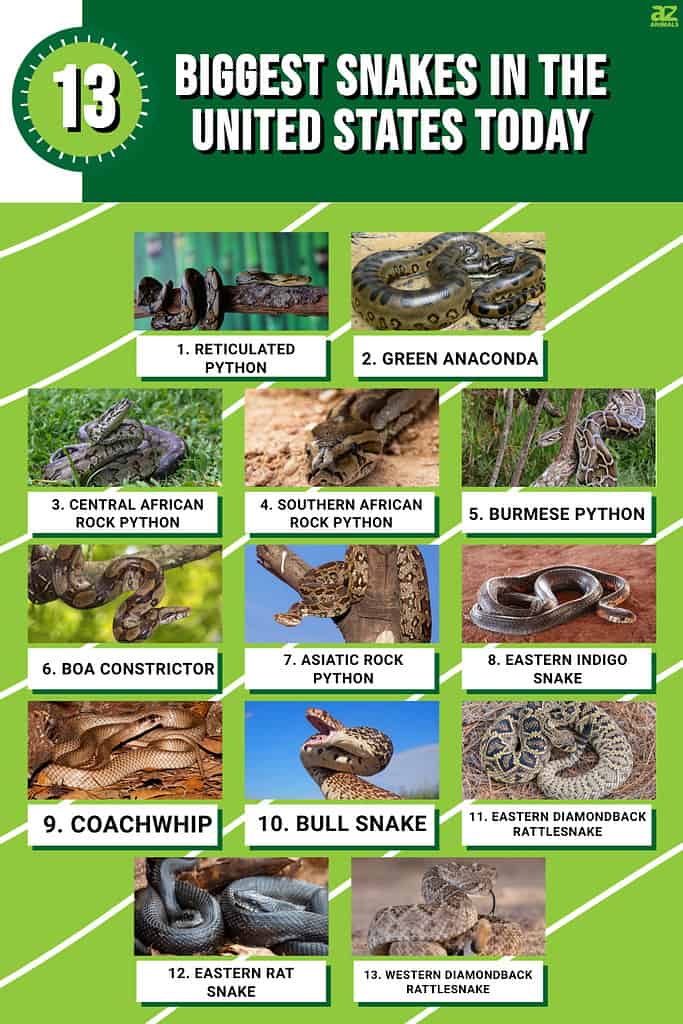
13. Western Diamondback Rattlesnake — 7 feet

Western diamondback
rattlesnakes
are found across the southwestern region of the U.S.
©Alexander Wong/Shutterstock.com
We’ll begin with the first of two venomous snakes on the list — the western diamondback rattlesnake (Crotalus atrox). Western diamondback rattlesnakes can reach 7 feet long and can inject a large amount of highly potent venom with a single bite, with the average venom yield being between 250 and 350 mg. Western diamondback rattlesnakes inhabit deserts, grasslands, rocky hillsides, and forests from central Arkansas to the central region of California. They are light gray to brown with dark diamond-shaped markings.
12. Eastern Rat Snake — 7.5 feet
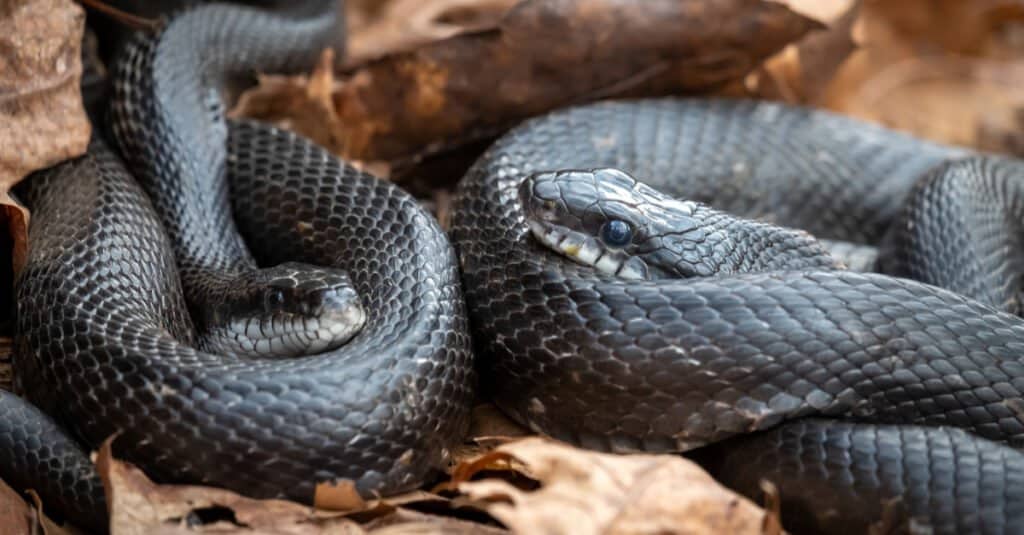
Eastern rat snakes can reach 7.5 feet long.
©samray/Shutterstock.com
Next, we have the eastern rat snake (Pantherophis alleghaniensis), which is also known as the black rat snake. They can reach 7.5 feet long and are black with white markings on their chin and throat. They also have a black and white belly with a checkerboard pattern. Eastern rat snakes live in a wide variety of habitats, including fields and woodlands close to urban areas. They are excellent climbers and may sometimes climb into attics. Eastern rat snakes are not venomous and instead kill by constriction. They prey on a range of rodents, birds, amphibians, and lizards.
11. Eastern Diamondback Rattlesnake — 8 feet

Eastern diamondback rattlesnakes live in the southeastern region of the United States.
©Chase D’animulls/Shutterstock.com
The second venomous snake on the list is the eastern diamondback rattlesnake (Crotalus adamanteus) which is often considered to be the most dangerous snake in the United States. This is because they have highly potent hemotoxic venom and a high venom yield — averaging 400 to 450 mg. They also have the longest fangs in proportion to their length out of all species of rattlesnake. Eastern diamondback rattlesnakes reach eight feet long and are typically tan to brown with large dark brown or black diamond-shaped markings. Their markings are also usually bordered with cream or yellow scales. Eastern diamondback rattlesnakes live in the southeastern region of the U.S., where they inhabit pine forests and flatwoods, cypress swamps, and sandy woodlands. They also often live in gopher burrows.
10. Bullsnake — 8 feet
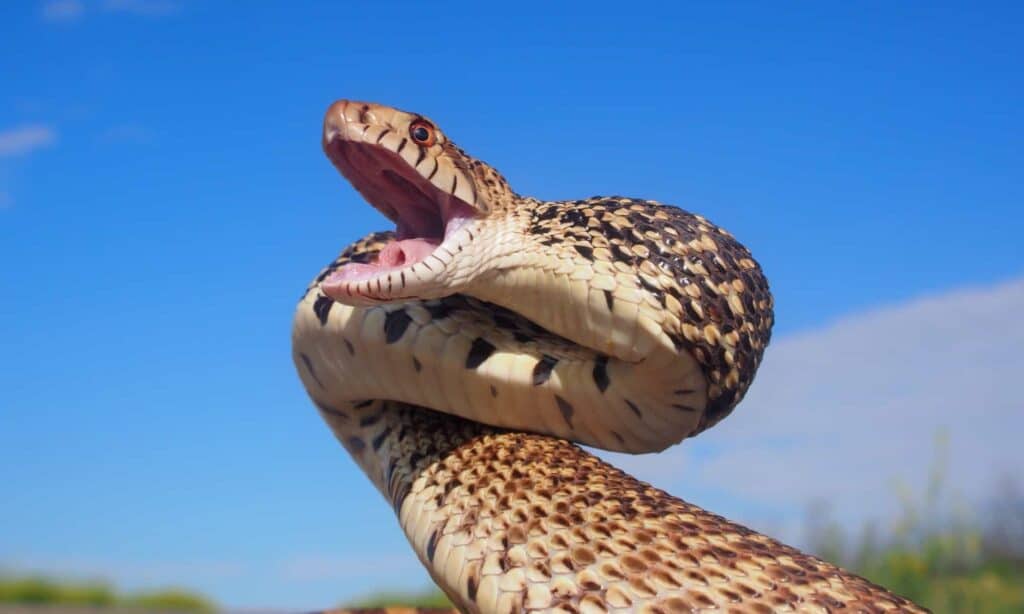
Bullsnakes often mimic rattlesnakes as a means of defending themselves.
©Markparker1983/Shutterstock.com
Another large snake in the U.S. is the bullsnake (Pituophis catenifer sayi). Bullsnakes are a subspecies of the gopher snake and have a maximum length of around 8 feet. Bull snakes are typically yellowish-colored with large dark brown, black, or sometimes reddish blotches. They live in a variety of habitats, including grasslands, woodlands, forests, and farmland. They are powerful snakes that kill by constriction. Their diet consists mainly of small mammals and birds. They even sometimes climb trees to raid nests and take both eggs and hatchlings. Although they are not venomous, bull snakes perform an impressive defensive display by mimicking a rattlesnake. They raise their head and body off the ground while flattening their neck and hissing. They also vibrate their tail in the leaf litter and attempt to strike while retreating from the threat.
9. Coachwhip — 8.5 feet
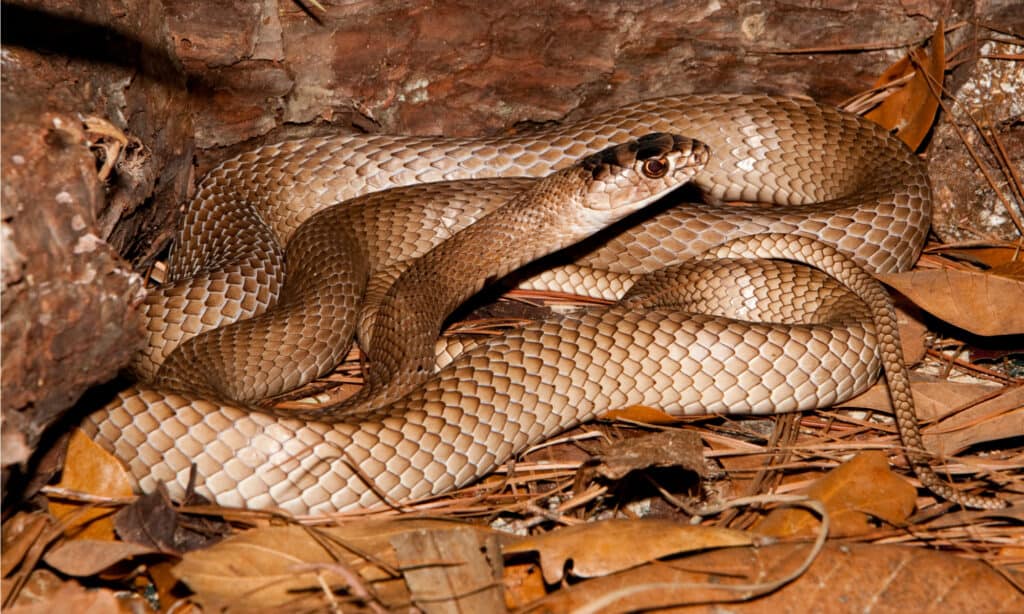
Coachwhip snakes are long, thin snakes that can reach 8.5 feet long.
©Jay Ondreicka/Shutterstock.com
A long snake with an unusual appearance is the coachwhip (Masticophis flagellum), which is named because it looks like a braided coachwhip. The nominotypical subspecies — the eastern coachwhip — typically has a black head and neck but their color gradually lightens to tan at their tail. They are also the longest subspecies and can reach 8.5 feet long. Coachwhips live in the southern region of the US and inhabit fields, prairies, and open forests. They are diurnal and prey on a variety of birds, rodents, and lizards. They are ambush predators but are not venomous. One of the myths surrounding coachwhips is that they are rumored to chase people and whip them with their tails. Luckily, this is untrue as they prefer to flee from danger, although they may strike if they are cornered.
8. Eastern Indigo Snake — 9 feet
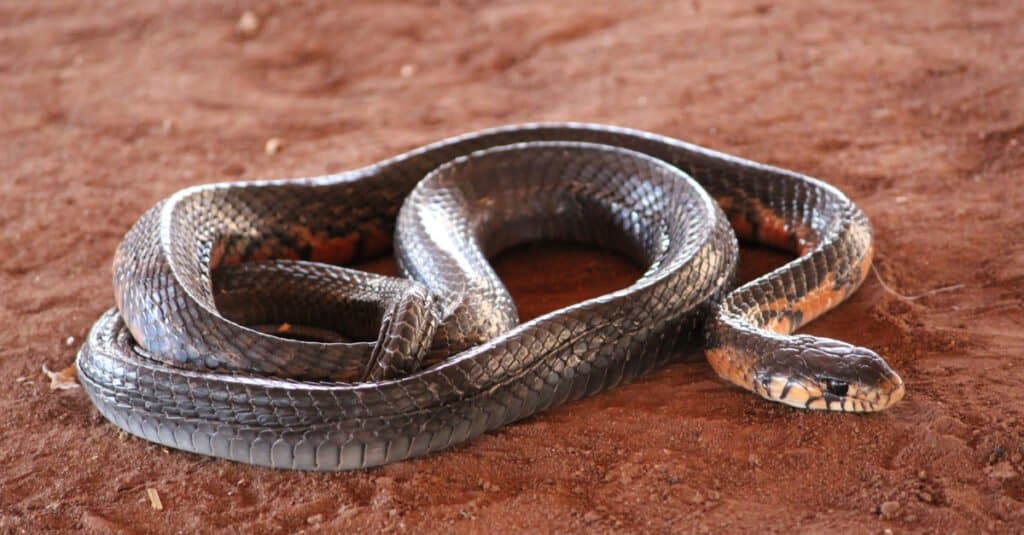
Eastern indigo snakes are the largest native snakes at 9.2 feet long.
©Alan Jimenez G/Shutterstock.com
The largest snake in the U.S. that is native to the country is the eastern indigo snake (Drymarchon couperi). Eastern indigo snakes live in the southeastern region of Mississippi to South Carolina. They live in hardwood forests, pine flatwoods, and cypress swamps. Eastern indigo snakes have smooth, blueish-black bodies with red or brown markings on their throat and chin. Eastern indigo snakes have a maximum reported length of 9.2 feet. They are considered to be apex predators within their range and prey on a variety of small mammals, birds, lizards, and amphibians.
7. Asiatic Rock Python — 10 feet
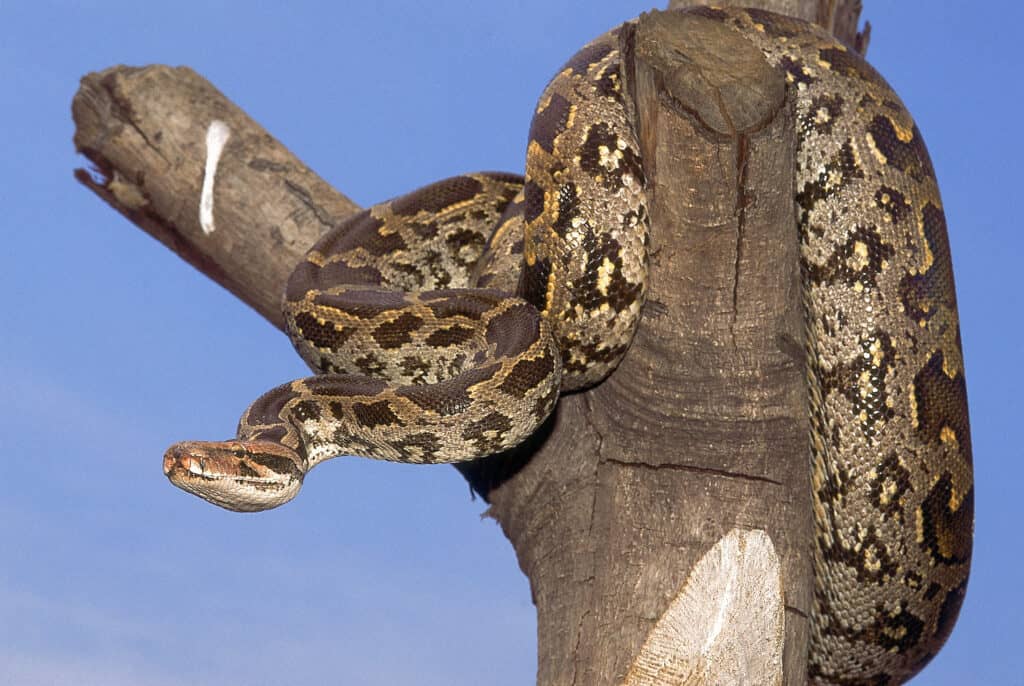
Asiatic rock pythons can now be found in several U.S. states, following their introduction through the exotic pet trade.
©iStock.com/ephotocorp
The next snake, and the first invasive snake on the list, is the Asiatic rock python (Python molurus), which is also known as the Indian python. These snakes are around 10 feet long and have a yellowish ground color that is overlaid with tan and dark brown blotches. Asiatic rock pythons are native to India but were introduced to the U.S. via the pet trade. They can be found in several states, including Texas, where they pose a serious threat to native wildlife. Asiatic rock pythons are constrictors and prey on a wide variety of mammals, birds, and reptiles.
6. Boa Constrictor — 15 feet
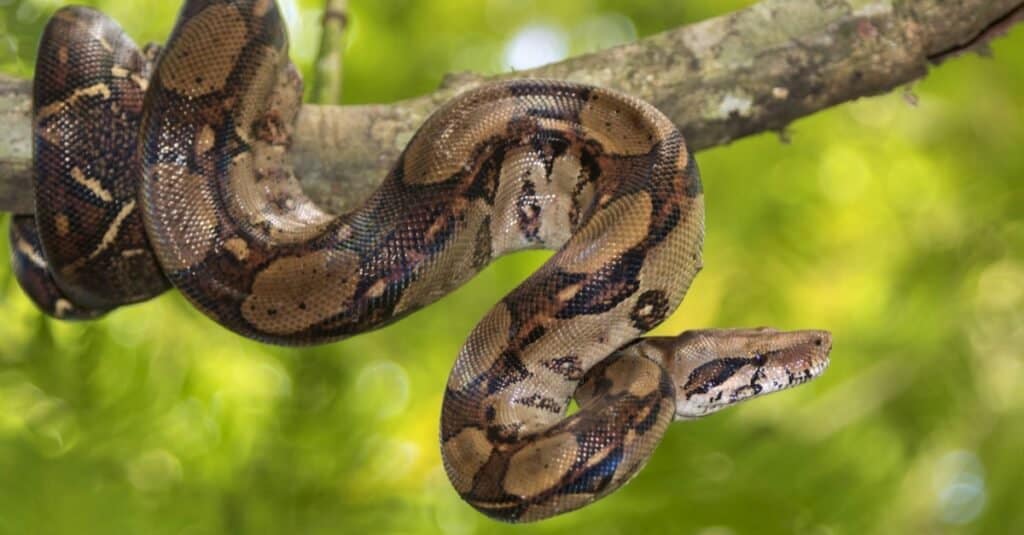
Boa constrictors are non-venomous snakes famous for their method of subduing prey by constricting it to death.
©Natalia Kuzmina/Shutterstock.com
Undoubtedly one of the biggest snakes in the U.S. is the boa constrictor — also known as the red-tailed boa — which can reach 15 feet long. Boa constrictors were again introduced through the exotic pet trade when they arrived in Florida in the 1960s and 1970s. There is now an established population of these snakes in the southern region, where they wreak havoc on the local animals. Boa constrictors are excellent climbers and swimmers and can live in a variety of habitats, including swamps, forests, and riverbanks. They are typically cream, gray, or brown with reddish-brown “saddle” markings which become larger and more prominent as they approach the tail.
5. Burmese Python — 16 feet
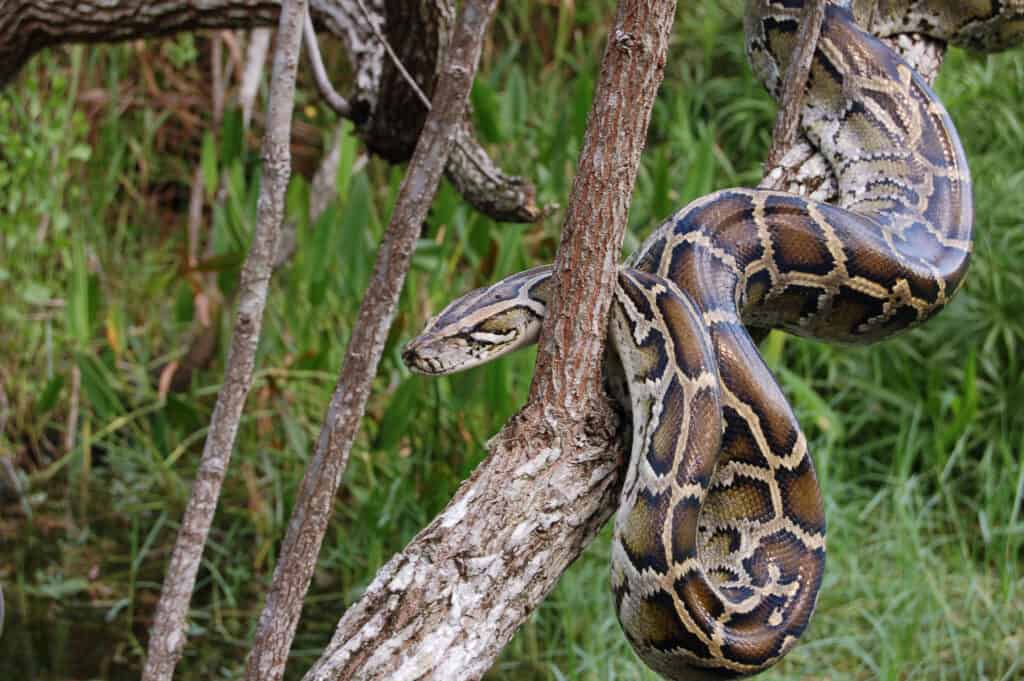
Burmese
pythons are one of the most invasive species in the Florida Everglades.
©Heiko Kiera/Shutterstock.com
Another large snake in the U.S. today is the Burmese python (Python bivittatus), which inhabits the Florida Everglades. They are the most invasive snakes in the state as they prey on a large number of endangered native animals, such as Key Largo woodrats. Since their introduction, the populations of several species of animals have reduced, both as a result of them being preyed on and because of the direct competition for food and space. Burmese pythons can reach 16 feet long and are dark brown with dark brown blotches that are bordered with black along their back.
4. Southern African Rock Python — 16 feet
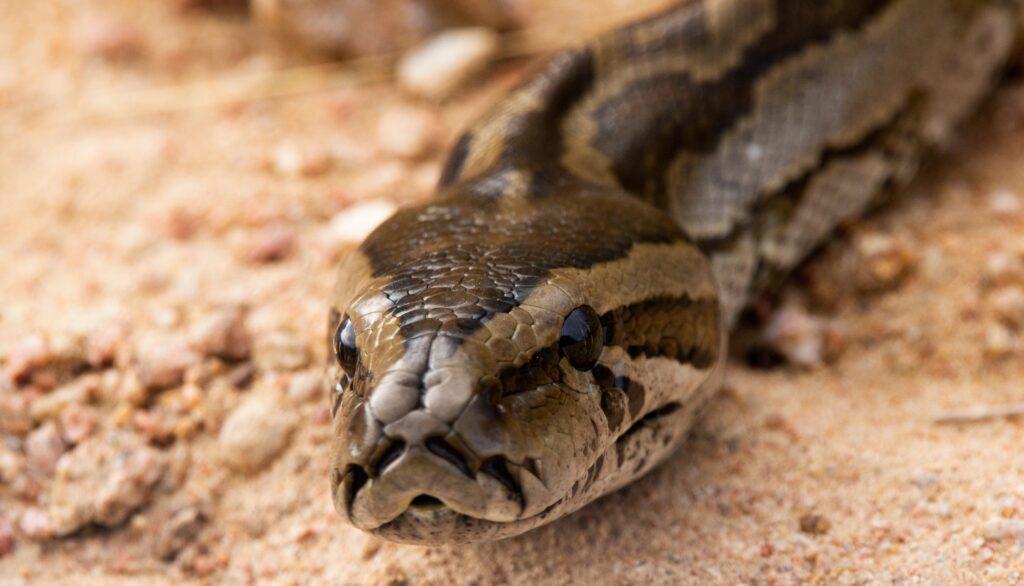
Southern African rock pythons inhabit Texas and can reach 16 feet long.
©Bruce Crossey/Shutterstock.com
Although they can reach a maximum length of 16 feet, southern African rock pythons (Python natalensis) are typically between nine and 13 feet long, with the females being the largest and the heaviest. They are typically brown with dark brown blotches that have lighter-colored borders. Southern African rock pythons are native to South Africa, although there is now an established population in Texas.
3. Central African Rock Python — 20 feet
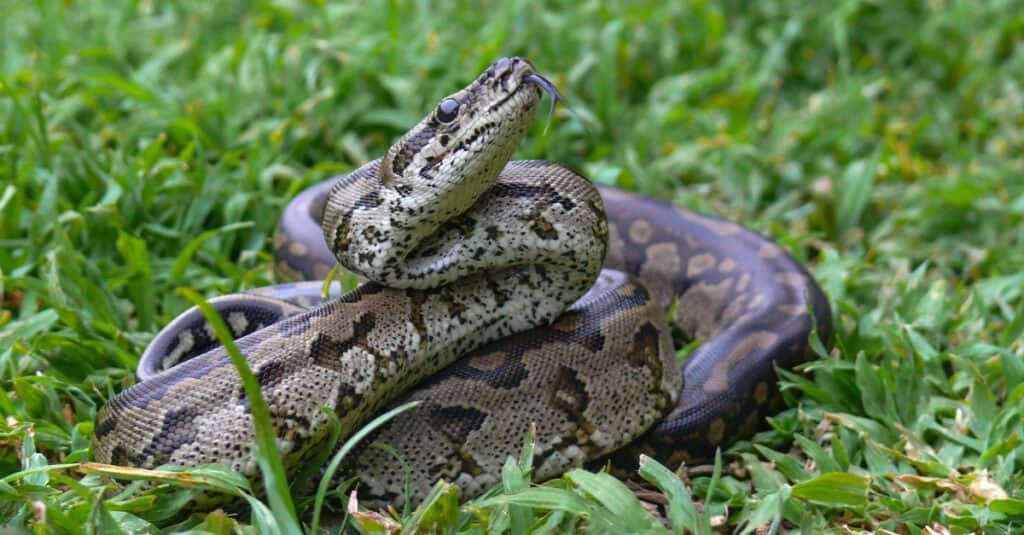
Central African rock pythons are massive snakes that eat anything they can overpower.
©Chris Graf/Shutterstock.com
Another huge python in the U.S. is the Central African rock python (Python sebae) which reaches 20 feet long. They have a similar appearance to the southern African rock python, with brown bodies and dark brown blotches. However, their markings are bordered with black instead of a lighter color. They also have a distinctive marking on either side of their head which joins at the top to form a unique spear shape. Central African rock pythons are native to sub-Saharan Africa and can survive in a wide variety of habitats. They have a reputation for eating anything that they can catch and overpower and have very few predators because of their size.
2. Green Anaconda — 30 feet
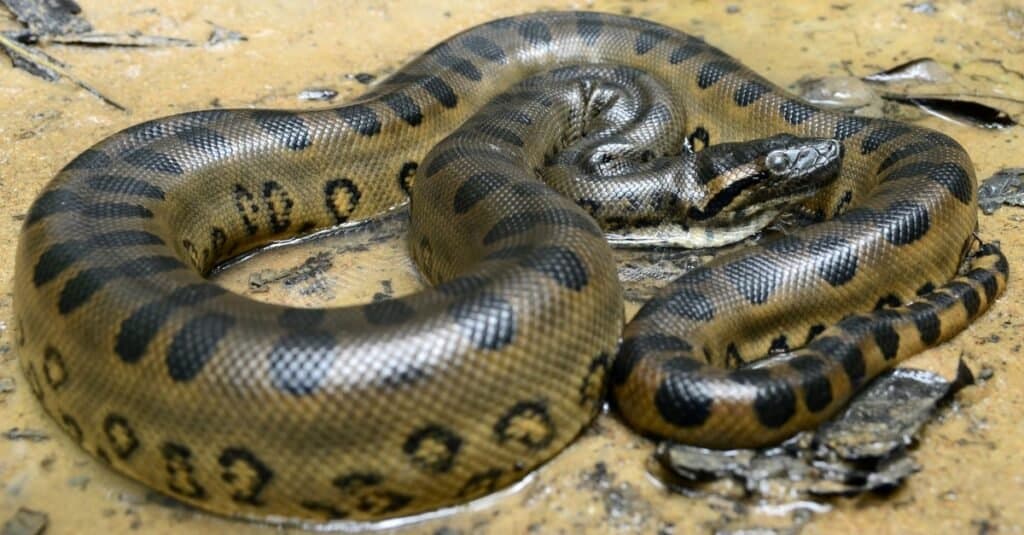
Green anacondas are one of the most powerful snakes in the world due to their large size.
©Patrick K. Campbell/Shutterstock.com
The heaviest snake in the US today and the second longest is the formidable green anaconda (Eunectes murinus). Green anacondas can reach 30 feet long and weigh as much as 550 pounds. They are olive green with black blotches, although they also sometimes have smaller yellow spots on their sides. Green anacondas have established themselves in several states, although the true population size is not known. They are good swimmers and live in areas close to water, such as swamps, streams, and rivers. Green anacondas are definitely not a snake that you want to accidentally stumble upon. They are apex predators and will eat anything that they can overpower — including larger animals such as deer. They are ambush predators and will often lie submerged in the water while waiting for the perfect moment to attack their prey.
1. Reticulated Python — 32 feet

Reticulated pythons can reach 32 feet long, although they are not as heavy as green anacondas.
©I Wayan Sumatika/Shutterstock.com
The biggest snake in the US today is the reticulated python (Malayopython reticulatus) which reaches a staggering 32 feet long. Again, although it is legal to keep these snakes in some states with the relevant permit, escaped or released pets have meant that there are small populations of them in some states. Reticulated pythons live in grasslands, forests, and woodlands, including in areas close to rivers and streams. They kill by constriction and typically prey on mammals. Reticulated pythons are brown with irregular diamond-shaped markings which are bordered with black.
Summary of the 13 Biggest Snakes in the United States
Here’s a recap of the 13 largest snakes currently found in the U.S. that we looked at.
| Rank | Snake | Length |
|---|---|---|
| 1 | Reticulated Python | 32 feet |
| 2 | Green Anaconda | 30 feet |
| 3 | Central African Rock Python | 20 feet |
| 4 | Southern African Rock Python | 16 feet |
| 5 | Burmese Python | 16 feet |
| 6 | Boa Constrictor | 15 feet |
| 7 | Asiatic Rock Python | 10 feet |
| 8 | Eastern Indigo Snake | 9 feet |
| 9 | Coachwhip | 8.5 feet |
| 10 | Bull Snake | 8 feet |
| 11 | Eastern Diamondback Rattlesnake | 8 feet |
| 12 | Eastern Rat Snake | 7.5 feet |
| 13 | Western Diamondback Rattlesnake | 7 feet |
The photo featured at the top of this post is © steve estvanik/Shutterstock.com
Discover the "Monster" Snake 5X Bigger than an Anaconda
Every day A-Z Animals sends out some of the most incredible facts in the world from our free newsletter. Want to discover the 10 most beautiful snakes in the world, a "snake island" where you're never more than 3 feet from danger, or a "monster" snake 5X larger than an anaconda? Then sign up right now and you'll start receiving our daily newsletter absolutely free.
Thank you for reading! Have some feedback for us? Contact the AZ Animals editorial team.






